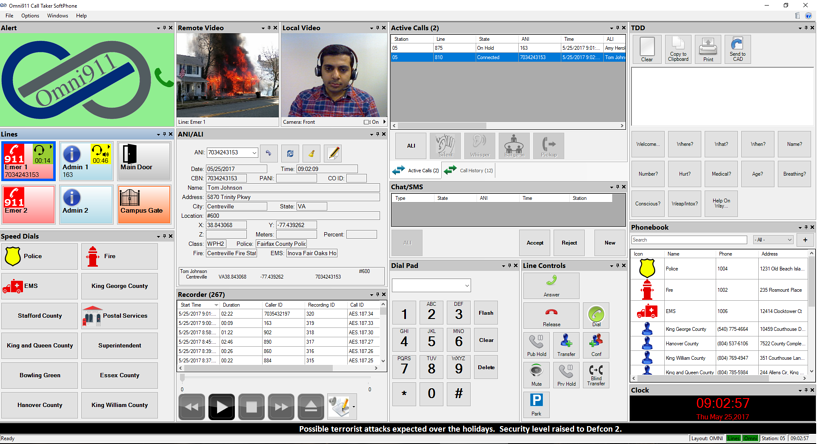Jun 16 2018 Five NG911 Features That Will Help Your PSAP Be More Effective

Efficient customer communication is critical to the success of business and industry. Operating a business with poor customer interaction dooms it to failure. A single instance of bad call handling and disjointed call management will ruin a company’s reputation from the customer’s perspective. So many companies operating customer contact centers invest in call management applications that minimize ring and hold times, and provide a streamlined and efficient call processing platform contributing to a positive customer experience.
At its heart, a PSAP is a call center, albeit a call center for critical, often life-threatening, and catastrophic events. If businesses consider their call processing solution essential to their success, a PSAP requires that and exponentially even more. There is an expectation of excellence in telecommunicators, they are required to be consummate professionals in all their interactions with the calling public. If PSAP staff are regarded with such high expectations, shouldn’t their technology be likewise held to high standards?
What is Next Generation 911?

Next Generation 911 (NG911) is the evolution of emergency calling from an analog based Public Switched Telephone Network (PSTN) to a digital internet based platform (Voice over Internet Platform [VoIP]). Given that over 70% of 911 calls are wireless, this transformation is only a natural reflection of technology and societal progress.
“Communications technologies available to the public and first responders have substantially outpaced the legacy communications technologies presently utilized by most Public Safety Answering Points in the 911 system.”
The advent of Enhanced 911 brought automatic number identification (ANI), automatic location identification (ALI), and Selective Routing along with the emergency call. By the end of 1999, 96% of the US was served by Enhanced 911. NG911 retains those features and delivers even more. SMS text messaging, images, video, internet of things (IoT) signals, and System Control and Data Acquisition (SCADA) control over the 911 system are advanced features that either directly or indirectly contribute to the efficiency of PSAPs.
How Does NG911 Help PSAPs Be More Effective?
It’s not just the PSAP that realizes operational efficiencies from NG911. Every member of the emergency response community will experience the benefits of NG911, from responder safety to improved delivery of public safety services. If it benefits public safety, it benefits the PSAP in its ultimate mission.
The following are five distinct benefits of NG911 that come from an article: 5 Ways NG911 Can Improve Your Agency (NG911, Next Generation 911 for Leaders in Law Enforcement, IACP, NSA, 911.gov):
1. Improve Responder Safety: Next Generation 911 functions such as text, image, and video can be routed to first responders so that they may analyze and develop strategies enroute. Fire Officers can see a picture of an automobile crash, a building fire, or other hazardous situation. Law Enforcement will see images of suspects or missing persons prior to arrival. They will be able to communicate via text with persons who cannot speak either due to disability or an imminent threat situation. Paramedics can see a heart attack victim’s EKG through telematics (IoT). It is the ultimate goal of a PSAP to elicit accurate, timely, and useful information from an emergency caller and deliver that same quality of information to responders so they are adequately prepared to arrive on scene.
2. Improve Efficiency: More precisely and more rapidly identifying the location of emergency callers, especially wireless callers, gets officers, firefighters, and medics to the correct location without sorting out the confusion of wrong addresses and unknown locations. NG911 offers the prospect of hot-transfer of 911 calls to an alternate PSAP if telephone service goes down or the center has to be evacuated. The ability to view traffic cameras can result in a dispatch before the first 911 call comes in. All of this has the potential to lesson PSAP communications with both the 911 caller and first responders.
3. Improved Public Safety: Even in the E911 world, call processing between a call-taker and a dispatcher takes time. With improved location accuracy and the ability to identify call type from an image or video, dispatch of emergency resources may be significantly expedited, thereby potentially improving the outcome. Domestic violence, structure fires, and periods of anoxia rapidly progress and facilitating faster response times is a direct benefit to the public.
4. Better Access for Special Needs Callers: Those with disabilities that make it difficult to reach a hard-wired telephone, will see the benefits of wireless voice, text, image, and video. Not only will they be able to initiate a voice 911 call, they can text or send an image or video; which, can generate an emergency response. They have the same access as anyone else [now].
5. Potential Cost Savings: Two distinct cost saving benefits of NG911 are (1) replacing CAMA trunks and their associated high cost, with IP based routing is not only more efficient, but significantly cheaper, and (2) neighboring PSAPs can partner to become each other’s back-up and eliminate the need for costly secondary centers. Network functionality will also make it easier to keep one’s neighbor’s informed and aware of the situation.
Public safety is a community of practice. Each discipline is not an isolated island, rather a unified set of unique services that contribute to the public good. It is not uncommon to see law enforcement, fire, and EMS working side-by-side on an incident to mitigate outcome. It is usually the PSAP that “gets the ball rolling” and facilitates information sharing in the process. So, what benefits public safety in general, benefits the PSAP.
